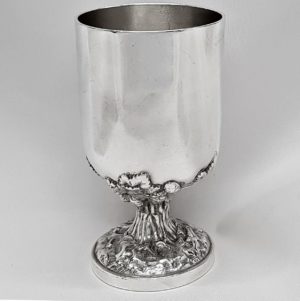Hamilton & Co
Robert Hamilton (1772-1848) arrived in India and started work in Calcutta in 1808. He opened his Jewellery and Silversmithing shop at 5 Tank Square in 1808 under licence from the East Indian Company.
In 1811 the business moved to 7 Court House Street, where it remained until 1973 when it finally closed. Needing capital to expand the business Robert Hamilton took two partners, Henry and James Glazbrook in 1811. Robert Hamilton’s interest ceased in 1817, and he dedicated the latter part of his life to collecting paintings, including works by Rubens, Velazquez and Holbein. During the subsequent years the business had many partners including: Henry and James Glazbrook, James Middleton, George Thoerpe, Charles Galliards, Alexander Rogers II, Henry Augustus Woolaston, William , Joseph, John and George Farrell Remfry, Robert John Dring and Thomas William Brookes. H&Co opened branches in other parts of India: Bombay (1833-36 and from 1868); Delhi and Simla (1865 onwards).
Jackson, in his famous book on British hallmarks of the beginning of 20th century, gives a small amount of information about Hamilton & Co, citations are reported as personal communication rather than written documents. A more exhaustive description (at least covering the first half of XIX century) by Wynyard Wilkinson, is in his famous and very rare book (only 1,000 copies produced) devoted to British silversmiths operating in India.
Hamilton & Co. is probably the best known and celebrated British silversmith operating in India (he is known as the Garrard of India). Among the main commissions received there is a vase for Rundell Bridge and Rundell in 1825. In 1844 Hamilton & Co. invents the Toffee pot, a coffee pot that can be also used as a teapot. His silver works are always elegant with minimal decoration (mainly plain design).
Information courtesy of Giovanni Ciceri – www.argentinglesi.com
Hamilton & Co
Robert Hamilton (1772-1848) arrived in India and started work in Calcutta in 1808. He opened his Jewellery and Silversmithing shop at 5 Tank Square in 1808 under licence from the East Indian Company.
In 1811 the business moved to 7 Court House Street, where it remained until 1973 when it finally closed. Needing capital to expand the business Robert Hamilton took two partners, Henry and James Glazbrook in 1811. Robert Hamilton’s interest ceased in 1817, and he dedicated the latter part of his life to collecting paintings, including works by Rubens, Velazquez and Holbein. During the subsequent years the business had many partners including: Henry and James Glazbrook, James Middleton, George Thoerpe, Charles Galliards, Alexander Rogers II, Henry Augustus Woolaston, William , Joseph, John and George Farrell Remfry, Robert John Dring and Thomas William Brookes. H&Co opened branches in other parts of India: Bombay (1833-36 and from 1868); Delhi and Simla (1865 onwards).
Jackson, in his famous book on British hallmarks of the beginning of 20th century, gives a small amount of information about Hamilton & Co, citations are reported as personal communication rather than written documents. A more exhaustive description (at least covering the first half of XIX century) by Wynyard Wilkinson, is in his famous and very rare book (only 1,000 copies produced) devoted to British silversmiths operating in India.
Hamilton & Co. is probably the best known and celebrated British silversmith operating in India (he is known as the Garrard of India). Among the main commissions received there is a vase for Rundell Bridge and Rundell in 1825. In 1844 Hamilton & Co. invents the Toffee pot, a coffee pot that can be also used as a teapot. His silver works are always elegant with minimal decoration (mainly plain design).
Information courtesy of Giovanni Ciceri – www.argentinglesi.com
-


1860
Hamilton & Co
9398 Antique Colonial Silver Goblet
Sold
A rare antique silver chalice of plain form, the stem and underbody having an unusual naturalistic design of acorns and foliage. Very thick gauge cast silver. Contains 865 ml. Weight 519 grams, 16.6 troy ounces. Height 17 cm. Diameter 9.2 cm. Marked on the bottom rim with Indian silver marks for Hamilton & Co, Calcutta. Circa 1860. A very similar style of goblet was made in England during the 1860’s by John Samuel Hunt and retailed by ‘Hunt & Roskell Late Storr & Mortimer’.